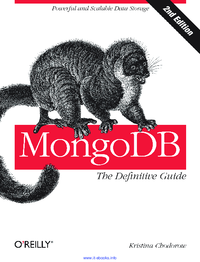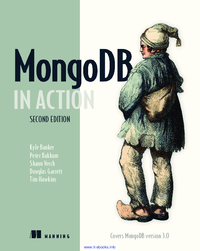Etiqueta "data bases"
Se han encontrado 4 Coincidencias
MongoDB: The Definitive Guide, Second Edition
Data Bases
172 Visitas | 229 Descargas | 2013-09-26 20:22:31 | cbustillo
MongoDB is a document-oriented database, not a relational one. The primary reason for moving away from the relational model is to make scaling out easier, but there are some other advantages as well. A document-oriented database replaces the concept of a “row” with a more flexible model, the “document.” By allowing embedded documents and arrays, the document-oriented approach makes it possible to represent complex hierarchical relationships with a single record. This fits naturally into the way developers in modern object oriented languages think about their data.

SQL Reference
SQL
138 Visitas | 191 Descargas | 2014-03-28 20:25:40 | josedanielr
This book is intended for anyone who wants to use the Structured Query Language (SQL) to access a database. It is primarily for programmers and database administrators, but it can also be used by general users using the command line processor. This book is a reference rather than a tutorial. It assumes that you will be writing application programs and therefore presents the full functions of the database manager.

SQL Pocket Guide
SQL
163 Visitas | 187 Descargas | 2014-03-28 20:28:35 | josedanielr
This book is an attempt to cram the most useful information about SQL into a pocket-size guide. It covers commonly used syntax for the following platforms: IBM DB2 Release 9.7, MySQL 5.1, Oracle Database 11g Release 2, PostgreSQL 9.0, and Microsoft SQL Server 2008 Release 2. Not all syntax will work on all platforms, and some features may not be available in earlier releases of these products. Whenever possible, I’ve tried to note any product or release dependencies.

MongoDB in Action
Data Bases
156 Visitas | 100 Descargas | 2016-04-06 22:47:40 | cbustillo
MongoDB in Action, 2nd Edition is a completely revised and updated version. It introduces MongoDB 3.0 and the document-oriented database model. This perfectly paced book gives you both the big picture you'll need as a developer and enough low-level detail to satisfy system engineers. MongoDB in Action, 2nd Edition is a completely revised and updated version. It introduces MongoDB 3.0 and the document-oriented database model. This perfectly paced book gives you both the big picture you'll need as a developer and enough low-level detail to satisfy system engineers. Lots of examples will help you develop confidence in the crucial area of data modeling. You'll also love the deep explanations of each feature, including replication, auto-sharding, and deployment.
Contribuir
Usted puede contribuir con Libros UCLV, es importante para nosotros su aporte..
Contribuir